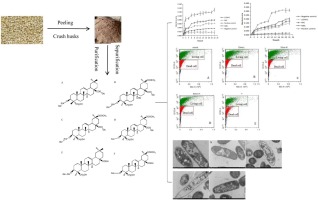Industrial Crops and Products ( IF 5.9 ) Pub Date : 2020-03-19 , DOI: 10.1016/j.indcrop.2020.112350 Shixia Dong , Xiushi Yang , Lei Zhao , Fengxiang Zhang , Zhaohua Hou , Peng Xue

|
The present study investigated the chemical composition of quinoa saponins and examined their possible antimicrobial modes of action against foodborne pathogenic bacteria.
Six different compounds (Q1-Q6) were extracted from quinoa husks, separated/purified by column chromatography and identified by HPLC/MS and NMR. The anti-bactericidal effects against six types of bacteria, Staphylococcus aureus, Staphylococcus epidermidis, Bacillus cereus, Salmonella enteritidis, Pseudomonas aeruginosa, and Listeria ivanovii, were determined by the disk diffusion method and assessment of the MIC/MBC. The changes in membrane integrity were tested using a microplate reader, a flow cytometer, and a transmission electron microscopy.
All the compounds exerted anti-bactericidal effects against S. aureus, S. epidermidis and B. cereus. Q4 showed the strongest activity against S. aureus and S. epidermidis, with an MIC value of 0.0625 mg/mL and an MBC value of 0.125 mg/mL. The concentration of quinoa saponin Q4 exhibited a dose-dependent relationship with its anti-bactericidal effect. In fact, a dose-effect relationship was found between the concentration of all quinoa saponins and their bacteriostatic effects. In addition, the release of nucleic acids and proteins from B. cereus increased gradually with increases in the Q4 concentration, and the membrane structure of B. cereus was destroyed by Q4.
Notably, quinoa saponins caused severe damage to the tested bacteria through degradation of the cell wall followed by disruption of the cytoplasmic membrane and membrane proteins, which resulted in leakage of the cell contents.
中文翻译:

藜藜藜的抗菌活性和作用机理。抵抗食源性致病菌的果壳
本研究调查了藜麦皂苷的化学成分,并研究了其对食源性致病细菌的可能抗菌作用。
从藜麦壳中提取六种不同的化合物(Q 1 -Q 6),通过柱色谱法分离/纯化,并通过HPLC / MS和NMR鉴定。通过圆盘扩散法和MIC / MBC评估,确定了对金黄色葡萄球菌,表皮葡萄球菌,蜡状芽孢杆菌,肠炎沙门氏菌,铜绿假单胞菌和伊氏李斯特菌六种细菌的抗菌作用。使用酶标仪,流式细胞仪和透射电子显微镜测试膜完整性的变化。
所有化合物均对金黄色葡萄球菌,表皮葡萄球菌和蜡状芽孢杆菌具有杀菌作用。Q 4对金黄色葡萄球菌和表皮葡萄球菌具有最强的活性,MIC值为0.0625 mg / mL,MBC值为0.125 mg / mL。藜芦皂苷Q 4的浓度与其抗菌作用呈剂量依赖关系。实际上,在所有藜麦皂苷的浓度与其抑菌作用之间发现了剂量效应关系。另外,蜡状芽孢杆菌核酸和蛋白质的释放随着Q 4的增加而逐渐增加浓度,蜡状芽胞杆菌的膜结构被Q 4破坏。
值得注意的是,藜麦皂苷通过细胞壁降解继而破坏细胞质膜和膜蛋白,从而对被测细菌造成严重损害,从而导致细胞内容物的泄漏。



























 京公网安备 11010802027423号
京公网安备 11010802027423号